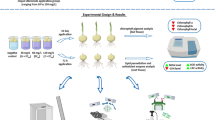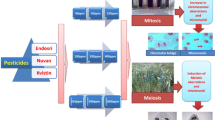Abstract
This study evaluated the mutagenic effects of two herbicides: Clorimurom Nortox® and Imazaquim Ultra Nortox® widely used on soybean crops in Brazil. As a test system, Allium cepa assay was used, which analyzes the frequency of micronuclei (MN), chromosomal aberrations (CA) and the mitotic index (MI). Four concentrations of each herbicide (50, 75, 100 and 125 %) were tested in triplicate using distilled water (negative control) and methyl methanesulfonate (positive control) as controls. Three experimental repetitions were realized. Clorimurom Nortox® showed a significantly lower MI than the negative control for the concentrations of 75, 100 and 125 %, but the CA was significantly increased at all concentrations. There was no recovery for CA or MI. The 125 % concentration of Imazaquim Ultra Nortox® was cytotoxic and also exerted an effect on the other parameters. The concentration of 100 % showed a statistically increased MN and there was no recovery, while the 75 % concentration significantly affected CA, with recovery observed. The two herbicides showed mutagenic damage in Allium cepa cells, which implies a careful handling of these products, to minimize the risk of human and environmental contamination.

Similar content being viewed by others

References
ANVISA: Brazilian Health Surveillance Agency. SIA—system of information about herbicides (2012) http://www4.anvisa.gov.br/AGROSIA/asp/frm_pesquisa_agrotoxico.asp. Access in April 2012
Ashraf H, Husain Q (2010) Studies on bitter gourd peroxidase catalyzed removal of p-bromophenol from wastewater. Desalination 262:267–272
Ateeq MB, Farah MA, Ali N, Ahmad W (2002) Clastogenicity of pentachlorophenol, 2,4-D and butachlor evaluated by Allium root tip test. Mutat Res 514:105–113
Barbério A, Voltolini JC, Mello MLS (2011) Standardization of bulb and root numbers for the Allium cepa test. Ecotoxicology 20(4):927–935
Bolle P, Mastrangelo S, Tucci P, Maria G, Evandri MG (2004) Clastogenicity of atrazine assessed with the Allium cepa test. Environ Mol Mutagen 43:137–141
Chandra S, Chauhan LKS, Murthy RC, Saxena PN, Pande PN, Gupta SK (2005) Comparative biomonitoring of leachates from hazardous solid waste of two industries using Allium test. Sci Total Environ 347:46–52
Chaparro TR, Botta CM, Pires EC (2010) Biodegradability and toxicity assessment of bleach plant effluents treated anaerobically. Water Sci Tecnol 62:1312–1319
Cotelle S, Masfaraud JF, Fe´rard JF (1999) Assessment of the genotoxicity of contaminated soil with the Allium/Vicia-micronucleus and the Tradescantia-micronucleus assays. Mutat Res 426:167–171
Dôssie ABRASCO – Um alerta sobre os impactos dos agrotóxicos na saúde, ABRASCO, Rio de Janeiro, junho de 2012. 2ª Parte. pp 1–137
El-Ghamery AA, El-Nahas AI, Mansour MM (2000) The action of atrazine herbicide as an indicator of cell division on chromosomes and nucleic acid content in root meristems of Allium cepa and Vicia faba. Cytology 65:277–287
Fatima RA, Ahmad M (2006) Allium cepa derived EROD as a potential biomarker for the presence of certain pesticides in water. Chemosphere 62:527–537
Feretti D, Zerbini I, Zani C, Ceretti E, Moretti M, Monarca S (2007) Allium cepa chromosome aberration and micronucleus test applied to study genotoxicity of extracts from pesticide-treated vegetables and grades. Food Addit Contam 24:561–572
Fernandes TCC, Mazzeo DEC, Marin-Morales MA (2007) Mechanism of micronuclei formation in polyploidizated cells of Allium cepa exposed to trifluralin herbicide. Pestic Biochem Physiol 88:252–259
Gadano A, Gurni A, Lopez P, Ferraro G, Carballo M (2002) In vitro genotoxic evaluation of the medicinal plant Chenopodium ambrosioides L. J Ethnopharmacol 81:11–16
Geras’kin S, Oudalova A, Michalik B, Dikareva N, Dikarev V (2011) Geno-toxicity assay of sediment and water samples from the Upper Silesia post-mining areas, Poland by means of Allium-test. Chemosphere 83:1133–1146
Grant WF (1982) Chromosome aberration assays in Allium, a reporto of U.S. Environmental protection agency gene-tox program. Mutat Res 99:273–291
Herrero O, Martin JMP, Freire PF, Lopez LC, Peropadre A, Hazen MJ (2012) Toxicological evaluation of three contaminants of emerging concern by use of the Allium cepa test. Mutat Res 743:20–24
Kirkland D (1998) Chromosome aberration testing in genetic toxicology: past, present and future. Mutat Res Fundam Mol Mech Mut 404:173–185
Komissarova EV, Saha SK, Rossman TG (2005) Dead or dying: the importance of time in cytotoxicity assays using arsenite as an example. Toxicol Appl Pharmacol 202:99–107
Koutros S, Lynch CF, Ma X, Lee WJ, Hoppin JA, Christensen CH, Andreotti G, Freeman LB, Rusiecki JA, Hou L, Sandler DP, Alavanja MC (2009) Heterocyclic aromatic amine pesticide use and human câncer risk: results from the U.S, Agricultural Health Study. Int J Cancer 124:1206–1212
Leme DM, Marin-Morales MA (2008) Chromosome aberration and micronucleus frequencies in Allium cepa cells exposed to petroleum polluted water: a case study. Mutat Res 650:80–86
Leme DM, Marin-Morales MA (2009) Allium cepa test in environmental monitoring: a review on its application. Mutat Res 682:71–81
Liman R, Ciğerci IH, Ozturk NS (2015) Determination of genotoxic effects of Imazethapyr herbicide in Allium cepa root cells by mitotic activity, chromosome aberration, and comet assay. Pestic Biochem Physiol 118:38–42
Linck AJ (1979) Effects on the cytology and fine structure of plant cells. Herbicides 1:83–121
Masood F, Malik A (2013) Cytotoxic and genotoxic potential of tannery waste contaminated soils. Sci Total Environ 444:153–160
Mitteregger H Jr, da Silva J, Arenzon A, Portela CS, Ferreira ICFS, Henriques JAP (2007) Evaluation of genotoxicity and toxicity of water and sediment samples from a Brazilian stream influenced by tannery industries. Chemosphere 67:1211–1217
Mustafa Y, Arikan ES (2008) Genotoxicity testing of quizalofop-P-ethyl herbicide using the Allium cepa anaphase-telophase chromosome aberration assay. Caryologia 61:45–52
Natarajan AT (2002) Chromosome aberrations: past, present and future. Mutat Res 504:3–16
Oliveira RS Jr, Constantin J (2001) Mecanismo de ação de herbicidas. Plantas daninhas e seu manejo. Agropecuária, Guaíba, pp 207–260
Pedrazzani R, Ceretti E, Zerbini I, Casale R, Gozio E, Bertanza G, Gelatti U, Donato F, Feretti D (2012) Biodegradability, toxicity and mutagenicity of detergents: integrated experimental evaluations. Ecotoxicol Environ Saf 84:274–281
Rank J, Nielsen MH (1994) Evaluation of Allium anaphase–telophase test in relation to genotoxicity screening of industrial wastewater. Mutat Res 312:17–24
Rank J, Lopez LC, Nielsen MH, Moretton J (2002) Genotoxicity of maleic hydrazide, acridine and DEHP in Allium cepa root cells performed by two different laboratories. Hereditas 136:13–18
Ribeiro LR (2003) Teste de Micronúcleo em Medula Óssea de Roedores In vivo. In: Ribeiro LR, Salvadori DMF, Marques EK, Canoas, Mutagênese Ambiental, p 174
Sobral O, Marin-Morales MA, Ribeiro R (2013) Could contaminant induced mutations lead to a genetic diversity overestimation? Ecotoxicol. doi:10.1007/s10646-013-1079-4
Spadotto CA (2006) Abordagem interdisciplinar na avaliação ambiental de agrotóxicos, Petrópolis, Vozes
Srivastava K, Mishra KK (2009) Cytogenetic effects of commercially formulated atrazine on the somatic cells of Allium cepa and Vicia faba. Peste Biochem Physiol 93:8–12
Turkoglu S (2007) Genotoxicity of five food preservatives tested on root tips of Allium cepa L. Mutat Res 626:4–14
Vidakovic-Cifrek Z, Pavlica M, Regula I, Papes D (2002) Cytogenetic damage in shallot (Allium cepa) root meristems induced by oil industry “High-Density Brines”. Arch Environ Contam Toxicol 43:284–291
Yıldız M, Cigerci IH, Konuk M, Fidan AF, Terzi H (2009) Determination of genotoxic effects of copper sulphate and cobalt chloride in Allium cepa root cells by chromosome aberration and comet assays. Chemosphere 75:934–938
Acknowledgments
Supported by Universidade Estadual do Oeste do Paraná (UNIOESTE), Fundação Araucária, Mr. Luiz Carlos Ribeiro and Herbioeste LTDA.
Author information
Authors and Affiliations
Corresponding author
Rights and permissions
About this article
Cite this article
Silveira, M.A.D., Ribeiro, D.L., dos Santos, T.A. et al. Mutagenicity of two herbicides widely used on soybean crops by the Allium cepa test. Cytotechnology 68, 1215–1222 (2016). https://doi.org/10.1007/s10616-015-9881-x
Received:
Accepted:
Published:
Issue Date:
DOI: https://doi.org/10.1007/s10616-015-9881-x



